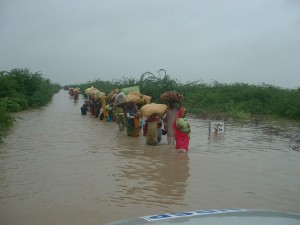
Barely had the people of Sindh recovered from the scars of the 2010 floods, when walls of waters returned knocking on their mud walls, drowning the most vulnerable women and children, sweeping livestock and destroying crops – leaving millions without shelter.
Almost as grave as the crisis unfolding across Sindh, is that it could have been contained. In July, the international donor agency Oxfam warned Pakistan that it was not ready for another natural disaster. To which governmental officials responded that dykes were plugged and embankments strengthened – and there was no cause for alarm.
So this monsoon, when Sindh hit the ice-berg, officials shifted the blame for their unpreparedness on the changing weather pattern. They contrasted the historical scale of the down pour with the 2010 floods. Then, the torrential rains in northern Pakistan had caused the Indus River to swell and burst its banks – taking huge waves toward the more urban settlements.
It is an argument that environmentalists in Pakistan refuse to buy. After last year’s floods, they cautioned the government that what was once considered “abnormal” weather should now be considered the “norm.”
Today, with water, water everywhere, relief agencies are at a loss to find dry land to pitch tent shelters. While the army and non governmental organizations like the Pakistan Fisher folk Federation ply rescue boats, they have few places to deposit the rescued. In the process, pregnant women have died for want of medical care.
The human sufferings have mounted as the roads leading from Karachi and Hyderabad have been inundated, cutting off assistance from urban dwellers. The administration claims that villagers are reluctant to leave their districts, hoping the waters will recede and they can go home.
Weeks after the monsoon rains lashed down in southern Pakistan, UN relief has begun coming in. The officials will tell you the request for assistance was made rather late by the government. Moreover, now that foreign aid is evident, the top brass are reportedly diverting it to their own home towns, rather than across the board.
All this is going on at a time when many villagers complain they have still not received compensation for the devastation they suffered last year. This time round, the destruction to livestock and almost 70 percent damage to the crops, threatens to push the peasants deeper into the unending cycle of poverty.
Back in 2005, when the earthquake struck in Kashmir, Pakistan created a National Disaster Management Authority. Today, the NDMA and its provincial branches struggle to cope with changing weather patterns. For a start, the government claims that its national meteorological service plans to take assistance from Japan to modernize its ability to predict and issue early warning systems for imminent disasters.
At this stage though, when the government appears to have abdicated in favor of foreign donors and philanthropists – the danger is especially pronounced for Sindh. This region of peace loving, mystical cultivators barely gets noticed while Pakistan draws attention to itself – albeit for the wrong reasons. As the waters pass over Sindh, there is a real possibility that the world will forget people in its most remote corners.


Thank you Nafisa for this informative piece. And now we are being told by those who neglected precautionary measures that the floods are a manifestation of God’s wrath for our sins. Does it mean that nothing will be done for the flood victims? Sad.
When I called some fellows displaced by floods in the interior Sindh who are currently taking refuge in Hyderabad Jamat Khanas and asked what kind of help FOCUS Pakistan is providing, they complained FOCUS Pakistan is focusing on Northern Areas of Pakistan. Interior Sind does not exist for FOCUS Pakistan.
Shabnam Lutafali